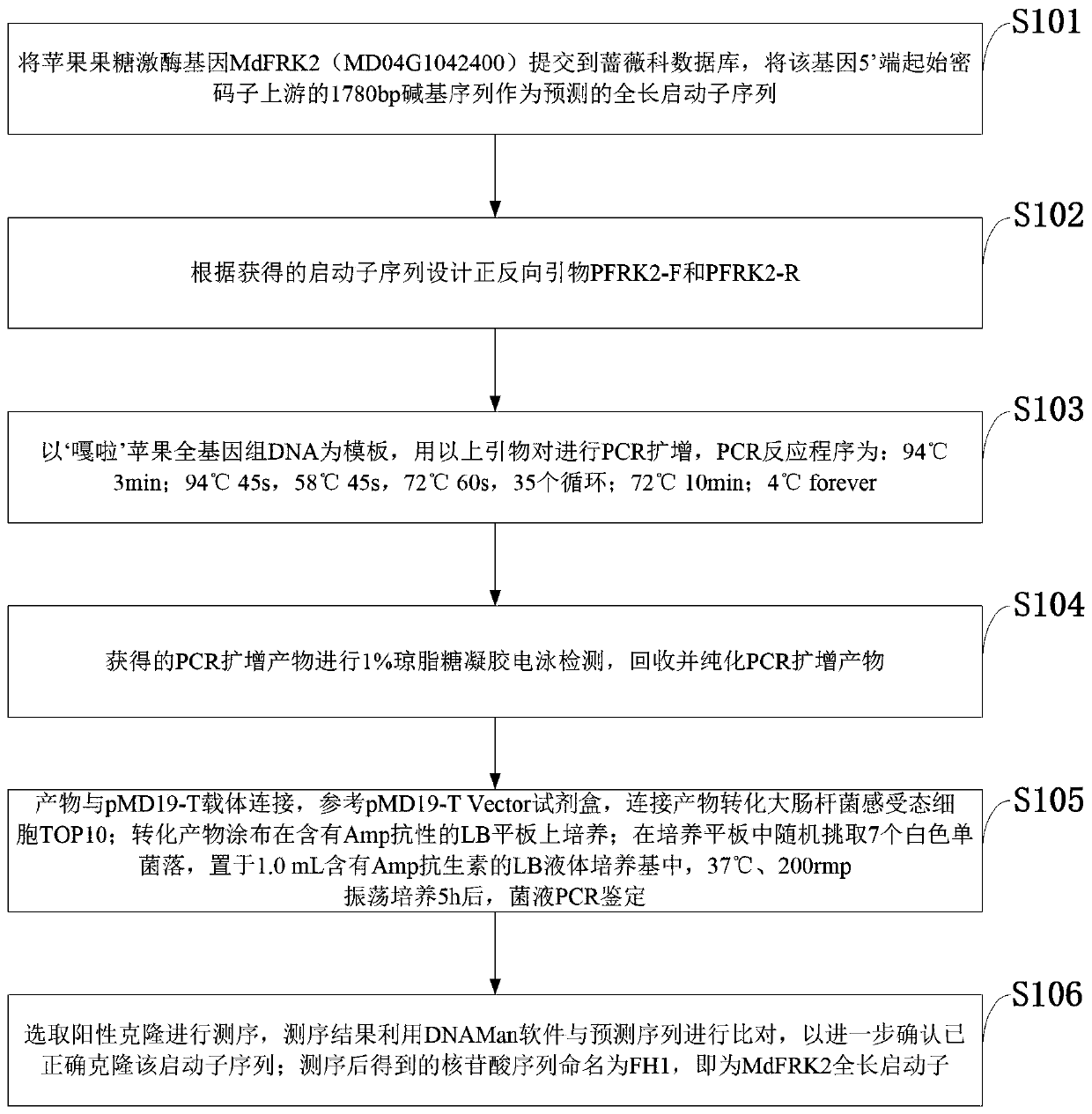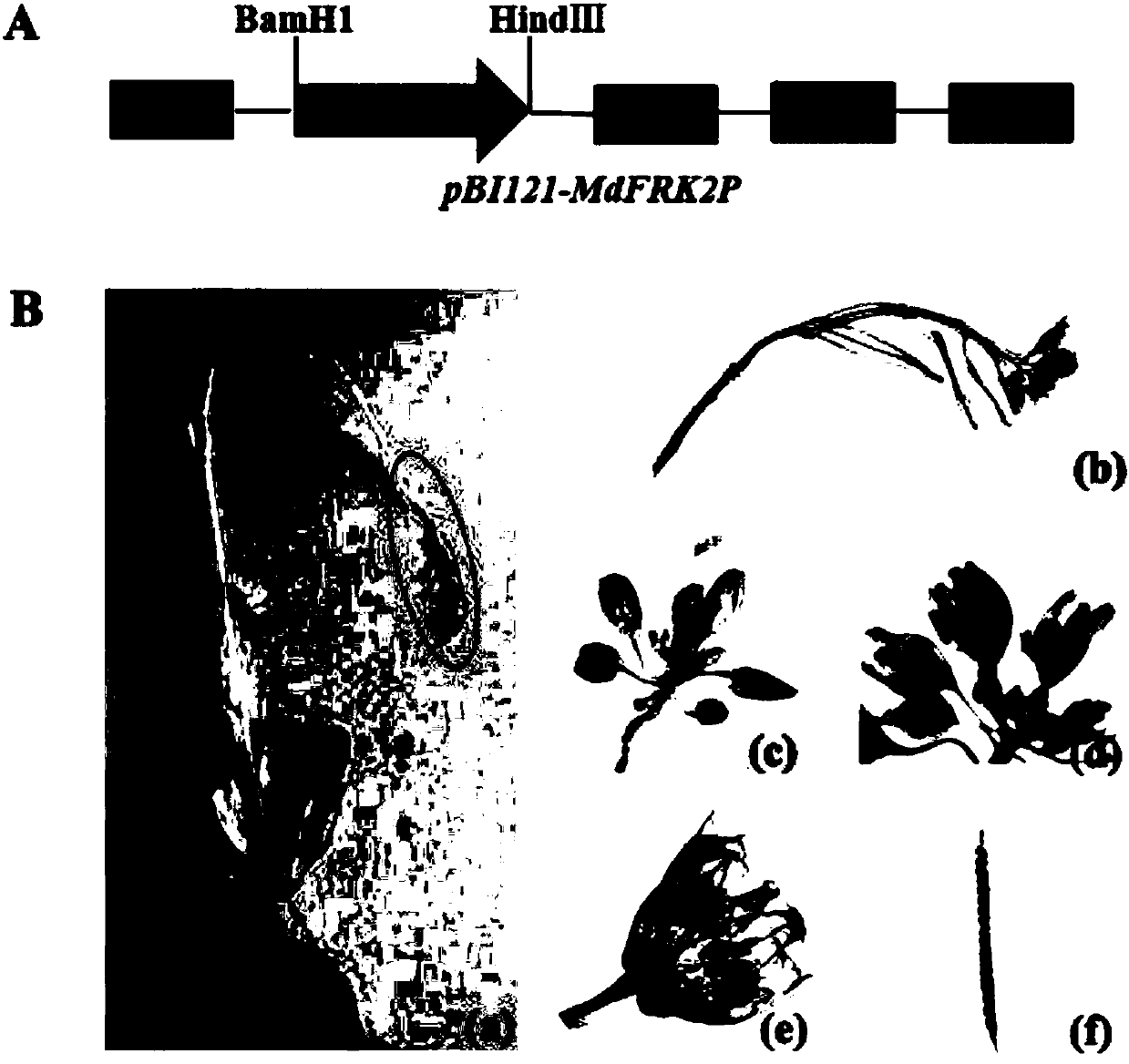Promoter sequence of fructokinase gene in apple, and deletion mutants and application of
A technology of promoter sequences and deletion mutants, applied in applications, genetic engineering, enzymes, etc., can solve problems such as hindering the normal growth of plants, breaking the metabolic balance, and dying.
- Summary
- Abstract
- Description
- Claims
- Application Information
AI Technical Summary
Problems solved by technology
Method used
Image
Examples
Embodiment 1
[0053] Example 1: Cloning of the MdFRK2 promoter
[0054] 1. Submit the apple fructokinase gene MdFRK2 (MD04G1042400) to the Rosaceae database https: / / www.rosaceae.org / search / features , the 1780bp base sequence upstream of the start codon at the 5' end of the gene was used as the predicted full-length promoter sequence.
[0055] 2. Design forward and reverse primers PFRK2-F and PFRK2-R according to the promoter sequence obtained above:
[0056] PFRK2-F: CGCGCGTACCGAGTCTAATCACTGC
[0057] PFRK2-R: GGCAGGCGTGCAAACTGGCGAATT
[0058] 3. Using the whole genome DNA of 'Gala' apple as a template, MdFRK2 was amplified by PCR with the above primers. The PCR reaction program was: 94°C for 3min; 94°C for 45s, 58°C for 45s, 72°C for 60s, 35 cycles; 72°C 10min at ℃; forever at 4℃.
[0059] 4. The obtained PCR amplification products were detected by 1% agarose gel electrophoresis, and the PCR amplification products were recovered and purified (for steps, refer to the DNA Purificatio...
Embodiment 2
[0061] Example 2: Construction of plant expression vector of full-length promoter of MdFRK2 gene and transformation of Agrobacterium
[0062] 1. Construction of recombinant plasmid pBI121-MdFRK2
[0063] 1) The forward and reverse primers SEQ ID NO: 4PFRK2-F and PFRK2-R in 2 of Example 1 are introduced with restriction sites.
[0064] BamHI-PFRK2-F: GGATCC CGCGCGTACCGAGTCTAATCACTGC
[0065] HindIII-PFRK2-R: GAATTCGGCAGGCGTGCAAACTGGCGAATT
[0066] 2) Perform PCR amplification using the correct sequence identified in Example 1 as a template, and perform electrophoresis detection, purification and recovery of the obtained PCR product. The method is the same as in Example 1 above.
[0067] 3) BamHI and HindIII double enzyme digestion was carried out on the above recovered product at 37° C. for 2 hours (the enzyme digestion procedure was carried out according to the instructions). At the same time, the pBI121-MdFRK2 vector was digested with BamHI and HindIII for 5h.
[0068] 4...
Embodiment 3
[0078] Example 3: Analysis of the expression pattern of the full-length promoter of the MdFRK2 gene
[0079] In order to study the tissue and organ expression characteristics of the promoter, the recombinant Agrobacterium pBI121-MdFRK2 / GV3101 in Example 2 was transformed into Arabidopsis thaliana and poplar respectively. The operation steps are as follows:
[0080] 1. Genetic Transformation of Arabidopsis
[0081] 1) Obtaining the MdFRK2 promoter from Arabidopsis thaliana
[0082]The recombinant Agrobacterium pBI121-MdFRK2 / GV3101 obtained in Example 2 was used to transform Arabidopsis thaliana. The conversion steps are:
[0083] a. When the bolting height of wild-type Arabidopsis plants is about 5 cm, select plants with better growth for infection.
[0084] b. Add 2 μL of Agrobacterium containing the recombinant plasmid PMdFRK2::GUS to 50 mL of LB liquid medium containing kanamycin, rifampicin and streptomycin, cultivate at 28°C until OD600=1.2-1.5, centrifuge at 4000rpm f...
PUM
| Property | Measurement | Unit |
|---|---|---|
| Melting point | aaaaa | aaaaa |
| Thickness | aaaaa | aaaaa |
Abstract
Description
Claims
Application Information
 Login to View More
Login to View More - R&D
- Intellectual Property
- Life Sciences
- Materials
- Tech Scout
- Unparalleled Data Quality
- Higher Quality Content
- 60% Fewer Hallucinations
Browse by: Latest US Patents, China's latest patents, Technical Efficacy Thesaurus, Application Domain, Technology Topic, Popular Technical Reports.
© 2025 PatSnap. All rights reserved.Legal|Privacy policy|Modern Slavery Act Transparency Statement|Sitemap|About US| Contact US: help@patsnap.com



